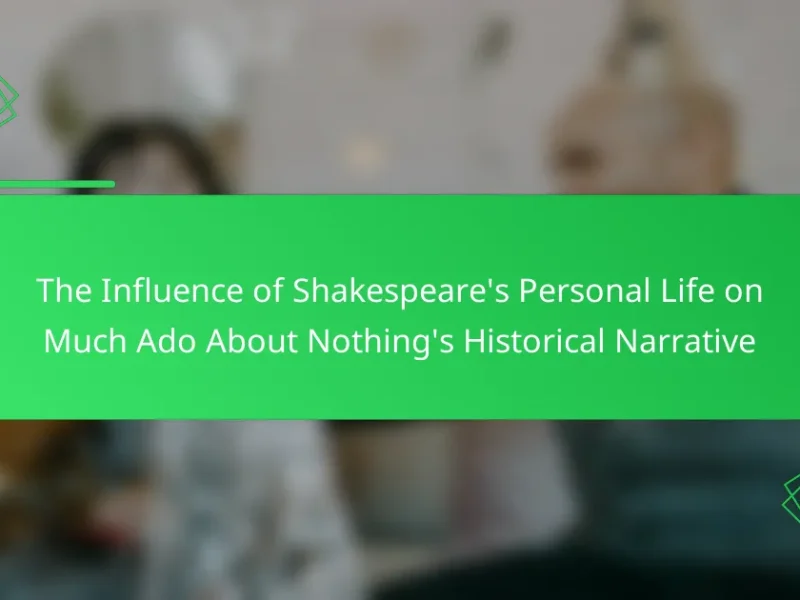
What are the key themes and motifs in Much Ado About Nothing?
The key themes in Much Ado About Nothing include love, deception, and honor. Love is portrayed through various relationships, especially between Benedick and Beatrice. Their witty banter highlights romantic tension and attraction. Deception plays a crucial role in the plot, with characters using trickery to achieve their goals. For example, the gulling of Benedick and Beatrice showcases how deception can lead to love. Honor is central to the characters’ actions, particularly in Claudio’s reaction to perceived dishonor towards Hero. This theme reflects societal expectations of fidelity and reputation. Additionally, motifs such as mistaken identity and eavesdropping further develop these themes throughout the play.
How do these themes reflect the historical context of the play?
The themes in Much Ado About Nothing reflect the historical context of the Elizabethan era. The play addresses issues of gender roles, honor, and social status prevalent during that time. For instance, the theme of honor is crucial, as a woman’s reputation directly impacts her family’s status. This mirrors the societal norms where women’s virtue was highly valued. Additionally, the play’s exploration of deception and misunderstandings highlights the complexities of social interactions in a patriarchal society. The comedic elements also reflect the era’s theatrical trends, emphasizing the importance of marriage and courtship. These themes resonate with the audience’s contemporary experiences, making the play relevant to its historical context.
What societal norms are depicted through the themes in Much Ado About Nothing?
Much Ado About Nothing depicts societal norms related to gender roles, honor, and marriage. The play emphasizes the expectations of women to maintain chastity and virtue. Characters like Hero represent the ideal woman, whose value is tied to her purity. Men, like Claudio, are shown to prioritize honor and reputation over personal relationships. The theme of deception reveals societal hypocrisy, as characters manipulate truths for social gain. Additionally, the play critiques the rigid class structures through interactions among nobles and commoners. Overall, the themes reflect the complexities of societal expectations in the Elizabethan era.
How do the themes relate to the gender roles of the Elizabethan era?
The themes in “Much Ado About Nothing” reflect the gender roles of the Elizabethan era by highlighting societal expectations. Women were often portrayed as subservient and focused on marriage. The theme of honor is central, emphasizing the importance of a woman’s chastity. Men were depicted as dominant figures responsible for protecting family honor. The play showcases the tension between individual desires and societal norms. Characters like Beatrice challenge traditional roles, representing a shift in female agency. This reflects the emerging discourse on women’s rights during the era. The contrasting portrayals of male and female characters illustrate the rigid gender dynamics of the time. Overall, the themes reinforce and critique the established gender roles of Elizabethan society.
What motifs are prevalent in Much Ado About Nothing?
Prevalent motifs in Much Ado About Nothing include deception, love, and honor. Deception drives the plot, influencing characters’ actions and relationships. Love is depicted in various forms, highlighting both romantic and platonic connections. Honor plays a crucial role, particularly in the context of reputation and social standing. These motifs intertwine to create tension and resolution in the narrative. The use of mistaken identities and misunderstandings emphasizes the theme of deception. Additionally, the contrast between romantic ideals and societal expectations showcases the complexity of love. Honor is tested throughout the play, affecting character decisions and outcomes. These motifs collectively contribute to the play’s exploration of human relationships and societal norms.
How do these motifs enhance the overall narrative of the play?
Motifs in “Much Ado About Nothing” enhance the overall narrative by reinforcing central themes. The motifs of deception and misunderstanding drive the plot forward. They create tension and conflict among characters. For instance, the masked ball leads to mistaken identities, influencing relationships. This misunderstanding propels the story and illustrates the folly of assumptions. Additionally, the motif of love, depicted through various relationships, deepens character development. It highlights the contrast between romantic ideals and reality. Ultimately, these motifs interconnect to emphasize the play’s message about love and honor.
What symbolic meanings do the motifs convey within the historical framework?
Motifs in “Much Ado About Nothing” convey various symbolic meanings that reflect societal values and norms of the Elizabethan era. For instance, the motif of honor highlights the importance of reputation and social standing. Characters like Hero and Claudio demonstrate how personal honor influences relationships and decisions. The motif of deception underscores the complexities of truth and perception, revealing societal hypocrisy. Additionally, the motif of marriage symbolizes both social contract and personal fulfillment, illustrating the tension between individual desires and societal expectations. These motifs collectively reflect the historical framework of gender roles and social structures during Shakespeare’s time.

How do the themes of love and deception manifest in Much Ado About Nothing?
The themes of love and deception in Much Ado About Nothing are intricately intertwined. Love is portrayed through various relationships, notably between Benedick and Beatrice. Their witty banter masks deeper feelings, highlighting the complexity of romantic emotions. Deception manifests primarily through the plot’s schemes, such as the gulling of Benedick and Beatrice into confessing their love. Claudio’s public shaming of Hero, based on false accusations, exemplifies the destructive potential of deception. This incident drives the narrative’s conflict and showcases how misunderstandings can jeopardize love. Ultimately, the resolution restores love, emphasizing its resilience despite deception’s challenges.
What role does deception play in the development of relationships?
Deception plays a significant role in the development of relationships in “Much Ado About Nothing.” It serves as a catalyst for misunderstandings and conflicts. Characters use deception to manipulate perceptions and influence emotions. For example, Claudio is deceived into believing that Hero is unfaithful, leading to a public shaming. This deception creates tension and drives the plot forward. Additionally, Beatrice and Benedick’s relationship evolves through a scheme that tricks them into admitting their feelings. Ultimately, deception reveals deeper truths about love and trust. The play illustrates how deception can both harm and transform relationships.
How does the theme of mistaken identities contribute to the plot?
The theme of mistaken identities significantly drives the plot in Much Ado About Nothing. It creates misunderstandings and conflicts among characters. For example, Claudio mistakenly believes that he has been deceived by Hero, which leads to a public shaming. This misunderstanding is fueled by the manipulation of Don John, who exploits mistaken identities for his own gain. The confusion caused by characters disguising themselves also leads to comedic situations. Additionally, the resolution of these mistaken identities contributes to character development and reconciliation. Ultimately, the theme reinforces the importance of communication and trust within relationships.
What are the consequences of deception for the characters involved?
Deception leads to significant emotional and relational consequences for the characters in Much Ado About Nothing. Characters like Claudio experience deep betrayal and shame after believing falsehoods about Hero. This results in public humiliation and a near-ruined marriage. Hero faces severe emotional distress, leading to her fainting and being thought dead. The deception causes a rift between friends, particularly between Benedick and Claudio. It also prompts Benedick to question his loyalty and relationships. Ultimately, deception disrupts social harmony and requires redemption and reconciliation efforts. The resolution showcases the lasting impact of deceit, highlighting the need for truth and trust in relationships.
How does the theme of honor influence the characters’ actions?
The theme of honor significantly influences the characters’ actions in Much Ado About Nothing. Honor drives characters to protect their reputations and social standing. For example, Claudio’s decision to publicly shame Hero stems from his perception of her dishonor. This act is rooted in societal expectations regarding fidelity and honor. Similarly, Benedick’s actions are influenced by his desire to uphold the honor of his friend Claudio. The characters often engage in duels or confrontations to defend their honor. This theme reflects the cultural norms of the time, where honor was paramount. The consequences of dishonor lead to conflict and misunderstandings among characters. Ultimately, the theme of honor shapes the narrative and character dynamics throughout the play.
What historical significance does honor hold in the context of the play?
Honor is historically significant in “Much Ado About Nothing” as it reflects societal values of the Elizabethan era. In this context, honor is closely tied to reputation and social standing. Characters like Claudio and Hero demonstrate how honor impacts relationships and personal identity. Claudio’s public shaming of Hero illustrates the severe consequences of dishonor. The play critiques the rigid expectations surrounding honor and its influence on behavior. Honor drives the plot, leading to misunderstandings and conflicts. Ultimately, the resolution underscores the importance of integrity over societal perceptions of honor.
How do characters navigate the expectations of honor in their relationships?
Characters navigate the expectations of honor in their relationships through adherence to societal norms and personal integrity. In “Much Ado About Nothing,” honor is often tied to reputation and familial loyalty. For instance, Claudio’s public shaming of Hero reflects the weight of honor in their relationship. He believes he must uphold his honor by rejecting her after hearing false accusations. Conversely, Beatrice challenges these expectations by prioritizing love over societal judgment. Her willingness to defy conventions highlights personal values over public perception. Additionally, the resolution of misunderstandings in the play restores honor, illustrating that relationships can be reconciled through truth and fidelity. The characters’ actions demonstrate the complex interplay between personal desires and societal expectations of honor.

What insights can we gain from the historical perspective of Much Ado About Nothing?
Much Ado About Nothing provides insights into societal norms and gender roles of the Elizabethan era. The play reflects the expectations of women to be chaste and obedient. Beatrice’s character challenges these norms by exhibiting independence and wit. The historical context reveals the tension between social expectations and individual desires. The theme of honor is central, as it relates to family reputation and personal integrity. Miscommunication and deception highlight the fragility of relationships in this period. Additionally, the play critiques the male-dominated society through its exploration of love and loyalty. Understanding these aspects enhances comprehension of the play’s enduring relevance.
How can understanding the historical context enhance our interpretation of the play?
Understanding the historical context enhances our interpretation of the play by providing insight into its themes and characters. Historical events, such as the role of women in the Elizabethan era, influence character motivations and societal norms depicted in the play. For instance, the expectation of female chastity significantly impacts the character of Hero. Additionally, the play addresses issues of honor and reputation, which were critical in Shakespeare’s time. Recognizing these historical factors allows audiences to grasp the complexities of relationships and societal pressures within the narrative. This deeper understanding can lead to a more nuanced appreciation of Shakespeare’s commentary on human behavior and social dynamics.
What specific historical events or cultural influences shaped the themes in the play?
The themes in “Much Ado About Nothing” are shaped by the societal norms of the Elizabethan era. The play reflects the importance of honor and reputation during the late 16th century. This period emphasized the roles of men and women in society, particularly regarding marriage and fidelity. The influence of courtly love is evident in the witty banter and romantic entanglements portrayed. Additionally, the cultural context of the time included a strong belief in the supernatural, which influenced character motivations and plot developments. The tension between appearance and reality is a recurring theme, reflecting the societal pressures of maintaining a facade. These historical and cultural influences provide a framework for understanding the characters’ actions and the play’s overarching messages.
How does the historical perspective inform our understanding of character motivations?
The historical perspective informs our understanding of character motivations by providing context for their actions and decisions. In “Much Ado About Nothing,” societal norms of the Elizabethan era shape characters’ views on honor and reputation. For example, the importance of marriage and social status drives characters like Claudio to act impulsively. Historical attitudes towards gender roles influence Beatrice’s assertiveness and Benedick’s reluctance to express vulnerability. These motivations reflect the constraints and expectations of their time. Understanding these historical contexts allows for a deeper analysis of characters’ complexities and conflicts.
What practical applications can be derived from the themes and motifs of Much Ado About Nothing?
The practical applications derived from the themes and motifs of Much Ado About Nothing include insights into human relationships, communication, and social dynamics. The theme of misunderstanding highlights the importance of clear communication. Misinterpretations lead to conflicts, emphasizing the need for dialogue in resolving issues. The motif of deception shows how appearances can mislead, suggesting the value of critical thinking. Additionally, the exploration of love and trust illustrates the necessity of honesty in relationships. These applications can be utilized in conflict resolution strategies and relationship counseling. Understanding these themes can enhance interpersonal skills in both personal and professional settings.
How can modern audiences relate to the themes presented in the play?
Modern audiences can relate to the themes presented in the play through universal human experiences. Themes such as love, deception, and honor resonate across time. For instance, the complexities of romantic relationships depicted in the play mirror contemporary dating dynamics. The theme of deception highlights how misunderstandings can arise in any era. Additionally, the exploration of social reputation remains relevant today, as individuals navigate public perception in their lives. The play’s humorous approach to serious themes allows audiences to reflect on their own experiences. Studies show that relatable themes enhance audience engagement, making the play timeless. Thus, the interplay of these themes fosters a connection between the play and modern viewers.
What lessons about relationships can be drawn from the motifs of Much Ado About Nothing?
The motifs in Much Ado About Nothing reveal important lessons about relationships. Trust and communication are central themes throughout the play. Characters experience misunderstandings due to lack of honest dialogue. For example, Claudio’s public shaming of Hero stems from his misinterpretation of events. This highlights the dangers of assumptions in relationships. Additionally, the contrast between Beatrice and Benedick showcases the power of wit and mutual respect. Their relationship evolves through banter, emphasizing the importance of friendship as a foundation for romance. Ultimately, the play teaches that open communication and trust are essential for healthy relationships.
The main entity of the article is “Much Ado About Nothing,” a play by William Shakespeare. The article explores key themes such as love, deception, and honor, and how these themes reflect the historical context of the Elizabethan era, particularly regarding gender roles and societal norms. It examines the impact of motifs like mistaken identity and eavesdropping on character relationships and plot development. Additionally, the article highlights the consequences of deception and the significance of honor in shaping character actions, providing insights into the complexities of human relationships during that time.


